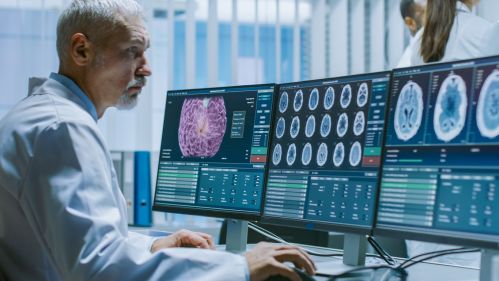Brain Cancer. How to overcome a dangerous disease?
The term “brain tumor” includes all brain tumors located inside the braincase and the spinal cord channel. Cancerous tumors should be considered as a consequence of the rapid and uncontrolled division of cells with abnormal structures. Tumors can be divided into primary tumors (growing from brain tissue) and secondary tumors (appearing as a result of the spread of metastases from other organs and systems).
Causes of brain cancer
The etiology of oncological pathologies of the brain has not been studied well yet, like most types of cancer. Among the most common hypotheses, causes of cancer are carcinogenic, traumatic, infectious, genetic, and viral theories. Co-factors that increase the risk of brain cancer, can be the bad environment, ionizing radiation, unhealthy diet. However, there is no full reply concerning the cause of cancer that affects the brain at the moment.

Classification of oncological diseases of CNS
A special classification has been created for tumors located in the central nervous system (last update in 2007). It provides around 100 different histological types of brain cancer divided into 12 categories. About 60% of all diseases is a neuroepithelial pathology, i.e. a disease generated by brain tissue. The most common type is glioma. It is a difficult-to-treat disease that has 4 degrees of course. The disease equally affects representatives of both sexes. It is inherent for all age categories. It can be located in any part of the brain. Meningioma is a cancerous disease progressing in the brain tissue. It amounts to around 25% of all existing CNS cancer pathologies. Pituitary tumors may grow as a result of head injuries, including birth ones, oxygen starvation of the brain tissue, pregnancy, and difficult labor pathologies. Pituitary adenoma also grows from its tissues, subsequently spreading to nearby parts of the brain.
Symptoms of oncological diseases
The manifestation of the disease often depends on the stage and location and size of a tumor. If there is a direct effect on and compression of certain parts of the brain, the symptoms will be more significant. However, some symptoms are the same for all types of cancer:
– Headache is one of the first and the earliest symptoms that can be indicative of the disease. It can occur equally for both benign and malignant diseases. The characteristic pain will be bursting. It may be dull and local. Most often, the greatest intensity is shown in the second half of the night’s sleep. It often becomes a cause of awakening. Stressful situations or exercise provoke amplification of pain symptoms. Classical headache occurs only in 17% of cases, more often they are one-sided (50% of cases). In other situations they occur spontaneously as a result of fatigue or over-strain;
– Vomiting. This symptom appears with no previous symptoms of nausea and is not associated with food intake (central vomiting). It may be reflexive or sudden. Most often, it occurs in the morning. It can be a result of body turning or sharp turn of the head;
– Increased intracranial pressure can cause dizziness, tinnitus, hearing and vision loss;
– Mental disorders are also common symptoms of brain tumors. They can manifest themselves in seizures, speech disorder, function, loss of coordination of movement and balance, sensory decrement.

Types and stages of cancer
The disease is identical to other oncological processes that can occur in the body. At the early stages, the tumor is within clear boundaries and is located within the place of its growth. At the later stages, the tumor grows and spreads, metastasizes, spreading pathology to other organs and systems of the body. It affects the lymphatic system. For oncological diseases of the central nervous system, not the stage of the disease, but the type of cancer is more relevant, which will determine the follow-up treatment. The fourth stage of cancer is considered the most severe and is difficult to treat, but the chance of recovery always remains. Modern methods of treatment are used in France today. They allow not only to defeat the disease but also to fully restore all the functions of the body.
Diagnostics and treatment of brain cancer in France
It is quite difficult to diagnose the disease at its early stages. The tumor located within the skull may not manifest itself for a long time. To determine the type of treatment, it is important to determine the localization of the tumor, its type, and size. Computer tomography, magnetic resonance imaging (MRI) and angiography (X-ray with contrast agent) are used for diagnostics. The combination of these diagnostic methods can give a clear picture of the disease. To precise the diagnosis, they can take tissue particles of the tumor (stereotactic biopsy). A sampling of neoplasms makes it possible to accurately determine the type of tumor. Electroencephalography (EEG) is based on the measurement of brain activity signals, which facilitates accurate detecting of the affected area as cancerous and normal cells respond to pulses differently.

Methods of treatment of brain cancer
There is no single prescription for all patients. In each case, an individual approach is required with the use of complex effects and different techniques. Having accurate diagnostic data, knowing the size and stage of the tumor, as well as its location and presence of metastases, the oncologist can develop a specific treatment strategy.
– Surgery is used if the tumor elimination does not affect vital areas of the brain. Surgery will be relevant if the detected center is single, and there are no metastases in the body;
– Radiation therapy is used when it is not possible to eliminate the tumor through surgery. The procedure involves exposure to radiation in the desired location, which helps to destroy the tumor;
– Chemotherapy increases the effect of drugs, radiation therapy, and hormonal therapy.
Modern cancer treatments
Today, the latest methods of treatment of oncological diseases are used in France. In particular, the method of virtual reality is used during surgeries. At the time of surgical intervention, the patient wears 3D glasses allowing him to be in virtual reality. This method allows the surgeon to monitor the process fully, keeping the vital areas of the brain from damage. Also, the use of virtual reality provides safety of vision. Professor Philip Minei actively used this technique and achieved excellent results. Surgical intervention has become high-precision. No nerve terminals responsible for the basic functions of the body have been affected during operations.
Why it is advisable to prefer treatment in France?
The country has the best level of development of medicine. France is among the leading countries in the world in this area. A wide scientific base has been created here. Many innovative discoveries in the treatment of cancer pathology belong to the French. Treatment of brain cancer in France includes modern approaches in the organization of the medical process. As a result, it has become quite possible to overcome this serious illness. The health care system in the country is actively supported by the government. Large funds are invested in scientific projects. The high level of medical care in the country is ensured by the professional medical staff, modern diagnostic equipment, accurate and thoughtful methods of treatment. The high qualification of French physicians allows to quickly determine an accurate diagnosis and order appropriate treatment. The statistics of recovery from this severe illness (brain cancer) is significantly higher than similar data in other countries. Today, every patient has a chance to recover, and French medicine proves this fact!
Please contact us for further information


















